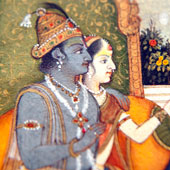Design Resource
Miniature Painting
Traditional Souvenirs
by
Prof. Bibhudutta Baral,Anisha Crasto and Anushree Kumar
Making a miniature painting involves a lot of intricate processes and stages and therefore the art is time-consuming. Following are the main steps:
- Preparing the surface
- Painting
- Finishing
Preparing the Surface:
Mainly the paintings are made on paper. Special handmade papers are procured from Sanganer and processed to make them suitable for painting. Handmade paper is called Basli. Two to three thin papers are stuck together with the help of starch to make them thick. It is then allowed to dry. After drying the surface is coated with a mixture of Khadiya and Gond. This mixture is prepared by dipping Khadiya in water for 4-5 hrs and allowing it to dissolve. After that, it is sieved and mixed with Gond. The mixture is allowed to dry and the hard lumps are ground to make the powder. This powder is again mixed with water to make the paste and applied to the paper. This paste gives strength and a better surface to the paper.
Painting:
The painting starts by sketching the borders with the help of a pencil. Thereafter the figures, trees etc. are made on the Basli. Sketches are made very lightly so that marks of pencils are not visible after the application of color. Once the sketching is done artisans start filling the colors. Application of colors starts with filling the base color and then followed by details. Shading and fine detailing of the face are done at the end with a fine squirrel brush. Face and facial expression are the most important part of the painting and are therefore done with utmost precision and patience. Chitrakars give special detailing on eyebrows, eye, eyelashes and lips etc. Borders of the garments and jewellery of gods, goddesses, kings and queens are painted with gold powder mixed with water. Sometime Varakh is also used. Once embellished the painting is allowed to dry properly.
Finishing:
After drying the painting is covered with butter paper and rubbed with a smooth oval-shaped stone. This smoothens the painting surface and gives a shine to the same. Sometimes artisans use potassium permanganate to apply to the paintings. This helps in overcasting the colors, giving it an antique look.












